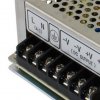Hello, I have a few (noobish) questions regarding AC/DC power converters (and general electronics questions) as I am building a home-made pinball machine and will most likely use a converter to power the solenoids (Power from an outlet, converted to DC current). I can really use some advice and feedback. I have a great knowledge for pinball machines but have limited knowledge of electronics.
I'm basing my questions on this http://www.circuitspecialists.com/ps1-150w-28.html converter (28V 5.5A).
1. I understand that the range for the input AC voltage is that of a standard wall outlet/voltage for houses. How do I connect an outlet to the converter? What is the correct procedure for wiring to a converter?
2. Can the output DC voltage be adjusted to lower than 28V? Can I have one circuit using 28V and say another using 5V (for lamps)?
3. When wiring the outputs, does the direction of V+ and V- matter? Do coils have polarity?
Thanks in advance for answers.
I'm basing my questions on this http://www.circuitspecialists.com/ps1-150w-28.html converter (28V 5.5A).
1. I understand that the range for the input AC voltage is that of a standard wall outlet/voltage for houses. How do I connect an outlet to the converter? What is the correct procedure for wiring to a converter?
2. Can the output DC voltage be adjusted to lower than 28V? Can I have one circuit using 28V and say another using 5V (for lamps)?
3. When wiring the outputs, does the direction of V+ and V- matter? Do coils have polarity?
Thanks in advance for answers.



